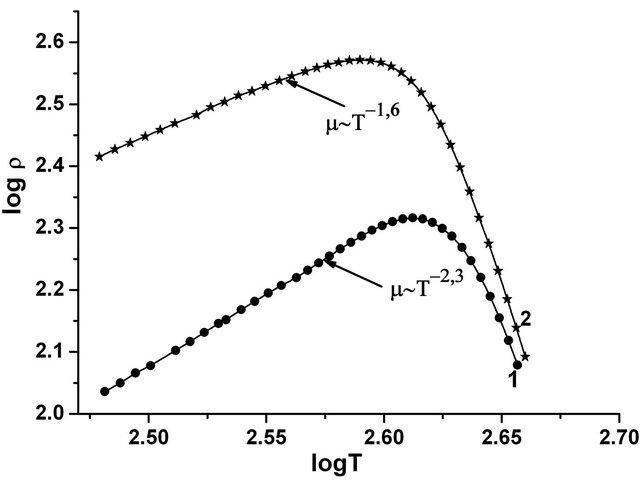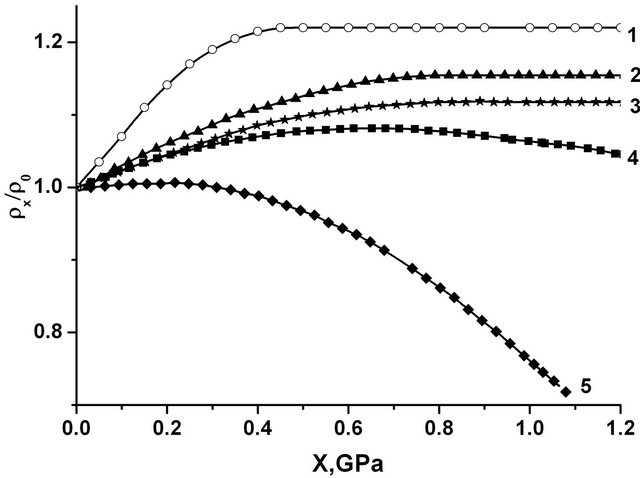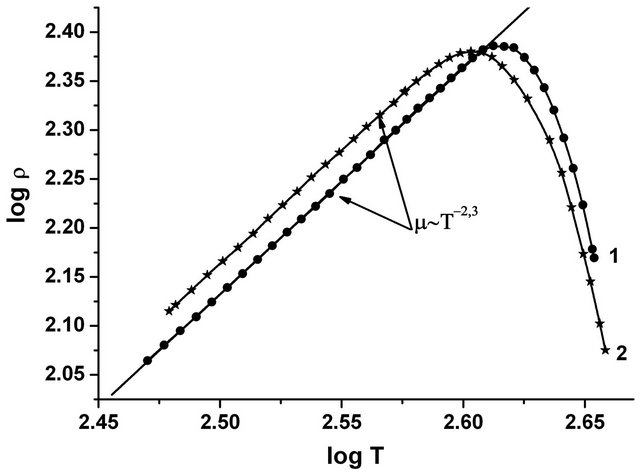World Journal of Condensed Matter Physics
Vol.3 No.1(2013), Article ID:28308,3 pages DOI:10.4236/wjcmp.2013.31007
Intervalley Scattering of Electrons in n-Si at T = 77 ( 450 K
![]()
1V. Lashkaryov Institute for Semiconductor Physics NAS of Ukraine, Kiev, Ukraine; 2Caspian State University, Aktau, Kazakhtan.
Email: ekol@isp.kiev.ua
Received October 9th, 2012; revised December 4th, 2012; accepted December 16th, 2012
Keywords: Silicon; f-Transitions; g-Transitions; Tensoresistivity Effect; Uniaxial Strain
ABSTRACT
The change in electron mobility of n-Si with increasing the temperature which may be due to the inclusion of gLOphonon energy of 720 K, is presented. Under orientation of the uniaxial pressure X//[110]//J, g-transitions are attached in the directions [100] and [010]. The f-transitions are not completely removed from valleys located in the plane (100). In this case, there is no change in the slope of the dependence logρ vs. logT for the temperature range 77 to 450 K. So, no appreciable contribution of g-transitions to intervalley scattering occurs, while the observed is the decisive role of ftransitions to intervalley scattering. The results of measuring of the tensoresistivity effect for n-Si crystals under X//[001]//J are presented at these temperatures too.
1. Introduction
Previously [1], the crucial role of f-transitions in intervalley scattering of electrons in n-Si with strong uniaxial pressures X//[001] and temperatures to 300 K was first demonstrated. In the same work, small contribution of g-transitions to this type of scattering was shown. It is unknown, however, whether the electron mobility wile change at T > 300 K, if there is the possibility of g-transitions, which, moreover, are not completely eliminated under strong uniaxial pressure X//[001].
The analysis of experimental data of many works on the study of fand g-transitions in n-Si indicates that the discussion of their role in intervalley scattering is not finished until now. This is due to the fact that silicon possesses a sufficiently wide set of phonons, which can make sufficiently comparable contribution of electrons to the intervalley scattering [2-7].
The scattering between Δ1 valleys that are aligned along the non-equivalent directions is caused by f-transitions. In these processes the phonons from Σ line are involved. According to the selection rules the TOand LOphonons with Σ1 symmetry are involved. Electron-phonon scattering between the valleys that are aligned along Δ is named g-transitions. This scattering is caused by the transitions in which the phonons are involved. In silicon these are the LO-phonons of  symmetry.
symmetry.
In [2] was determined that electron interaction with g-type phonons is approximately in one and a half lower and the interaction with the f-type phonons is nearly twice as powerful as previously reported [7]. Howeverfor he equilibrium condition low-energetic transition with assistance of g-phonons are forbidden. The change in mobility with increasing temperature may be due to inclusion of intervalley scattering related with g-transitions. Their contribution can increase with increasing temperature as a result of gLO-phonon energy of 720 K, deformation potential constant of which is »7.5 × 108 eV/cm. We used the direction of uniaxial pressure X//[110]//J to change at T > 300 K g-value and f-transitions in intervalley scattering. In this orientation of the uniaxial pressure, g-transitions are attached in the directions [100] and [010]. Furthermore, with strong intervalley scattering in uniaxial pressures, f-transitions between valleys [001] and [100] and [ī00]; [00ī] and [100] and [ī00]; [001] and [0ī0] and [010]; and [00ī] and [0ī0] and [010] (Figure 1) are excluded, and thus their intensity as compared to that in unstrained crystals decreases. This type of experiment gives us confidence that if there is significant contribution of gLO-conversion to the intervalley scattering of electrons in silicon at T = 77 ¸ 450 K.
As known, “Intel Corporation” introduced n-MOS transistors with silicon uniaxial deformed in the direction [001] channels, thus increase the mobility of electrons around twice at T = 300 K [8,9]. This increase is due to removal of intervalley scattering related with f-transitions, thereby increasing the steepness of the currentvoltage characteristics (CVC) and cutoff frequency of switching.
2. Experimental
For the investigation of the intervalley scattering of elec-

Figure 1. Scattering of electrons in n-Si for X//[110] X = 1.2 GPa.
trons in n-Si at T = 77 ¸ 450 K the specimens had sufficiently low donor concentration and namely 4 × 1013 cm−3. Sample dimensions were (0.7 × 0.7 × 10) mm3 for longitudinal investigation geometry. In all the cases the quantity E don’t over the limit of 0.5 V/cm. The accuracy of the X-ray method for determining the crystallographic orientation was ±15². After mounting a sample on the experimental setup the precision of its orientation with respect to the applied stress was not less than ±30². We used the installation for transport phenomena investigation under high uniaxial pressure described previously [10].
3. Results and Discussion
In this work we used the tensoresistivity (TR) effect at different directions of uniaxial pressure and temperature dependence of resistivity r = r(Т) in uniaxial deformed and undistorted crystal n-Si for the temperature range T = 77 ¸ 450 K. This temperature range covers the region of intrinsic conductivity of silicon crystals, so all conclusions about the impact of fand g-transitions are limited to the temperature at which the intrinsic conductivity sets in.
Figure 2 presents the results of measuring the tensoresistivity effect for n-Si crystals under X//[001]//J at different temperature. The view of data dependencies shows that under uniaxial pressure X = 1.2 GPa at temperatures T = 77 ¸ 450 K, redistribution of carriers between valleys is completely finished, and the dependence of  goes to saturation (curves 1 - 4). Clearly, the saturation function of r(Х) is characterized by lack absence of manifestations of f-transitions, and the possible presence of high gLO-temperature transitions in intervalley scattering. In the case of uniaxial pressure in the direction X//[001] the exponential law of changes in mobility m ~ Т−2,3 at X = 0 (Figure 3 curve 1) and with strong uniaxial pressure X = 1.2 GPa - m ~ T−1,6 (Figure 3 curve 2) it has been shown. It is under this pressure the f-transition of intervalley scattering is completely removed, indicating their crucial contribution to the intervalley scattering at Х = 0. Thus at X//[001] when the
goes to saturation (curves 1 - 4). Clearly, the saturation function of r(Х) is characterized by lack absence of manifestations of f-transitions, and the possible presence of high gLO-temperature transitions in intervalley scattering. In the case of uniaxial pressure in the direction X//[001] the exponential law of changes in mobility m ~ Т−2,3 at X = 0 (Figure 3 curve 1) and with strong uniaxial pressure X = 1.2 GPa - m ~ T−1,6 (Figure 3 curve 2) it has been shown. It is under this pressure the f-transition of intervalley scattering is completely removed, indicating their crucial contribution to the intervalley scattering at Х = 0. Thus at X//[001] when the

Figure 2. Dependence of  in n-Si (nе = 4 × 1013 сm−3) for X//[001]//J at different temperatures: 1 - 77; 2 - 300; 3 - 320; 4 - 350; 5 - 400; 6 - 450 K.
in n-Si (nе = 4 × 1013 сm−3) for X//[001]//J at different temperatures: 1 - 77; 2 - 300; 3 - 320; 4 - 350; 5 - 400; 6 - 450 K.

Figure 3. The dependence of ρ = ρ(Т) in double logarithmic scale in n-Si (nе = 4 × 1013 cm−3) for X//[001]//J: 1 - X = 0; 2 - X = 1.2 GPa.
f-transitions are completely eliminated the slope of the lg μ - lg T dependence changes from −2.3 to −1.6.
For greater confidence in the decisive contribution of ftransition in intervalley scattering, we used the uniaxial pressure direction X//[110], in which the g-transitions in the directions [100] and [010] are added. Also, f-transitions are not completely removed, and f-transitions between valleys located in the plane (100) remain (Figure 1).
Figure 4 represents the results of measurements of the TR effect for n-Si crystals under Х//[110]//J at different temperatures T, K.
In this case, there is no change in the slope of logr vs. logT dependence on the transition from the unstrained crystal n-Si to uniaxial-deformed. The value of this slope corresponds to the exponential law of changes in mobility m ~ Т−2,3 (Figure 5), indicating the absence of appreciable contribution of g-transitions in intervalley scattering of electrons and the presence of a decisive contribution to f-transition of intervalley scattering in temperature

Figure 4. Dependence of  in n-Si (nе = 4 × 1013 cm−3) for X//[110]//J at temperatures: 1 - 77; 2 - 300; 3 - 350; 4 - 400; 5 - 450 K.
in n-Si (nе = 4 × 1013 cm−3) for X//[110]//J at temperatures: 1 - 77; 2 - 300; 3 - 350; 4 - 400; 5 - 450 K.

Figure 5. Dependence of ρ = ρ(Т) in double logarithmic scale for n-Si (nе = 4 × 1013 cm−3) for X//[110]//J: 1 − X = 0; 2 − X = 1.2 GPa.
range T = 77 ¸ 450 K.
4. Conclusions
The tensoresistivity effect in Si is experimentally studied at the temperatures T = 77 ¸ 450 K. It is shown that at X//[001] when the f-transitions are completely eliminated the slope of the lg μ - lg T dependence changes from −2.3 to −1.6. A significant change in the slope depending on m vs. T in the pass from unstrained silicon μ ~ Т−2,3 to uniaxial strained crystals μ ~ Т−1,6 for X//[001] indicate a decisive contribution of f-transitions to intervalley scattering. In the case X//[110] at strong uniaxial strain 4 ftransitions and 2 g-transitions remain. The uniaxial stress does not change the slope of the lg μ - lg T dependence that points to the dominant contribution of f-transitions to the intervalley scattering.
We have established that the absence of changes in the slope of this relationship in the X//[110] indicates the absence of substantial contribution of g-transitions in intervalley scattering of electrons in this temperature range and the presence of decisive contribution of f-transitions to the intervalley scattering. Moreover for the equilibrium condition low-energetic transition with assistance of g-phonons are forbidden.
The uniaxial deformation can be also used to increase the mobility of electrons in the devices operated at T > 300 K.
In the temperature range T = 77 ¸ 450 K at high temperature band for the temperature dependencies logr − logT the silicon intrinsic conductivity begins. Therefore, to determine the slope of logr − logT dependence, we use there a comparatively narrow temperature range.
REFERENCES
- P. I. Baranskii, I. V. Dakhovskii, V. V. Kolomoets, et al., “Intervalley Scattering in n-Si for Temperature Range 78 - 300 K,” Semiconductors, Vol. 10, No. 8, 1976, pp. 1480 -1482.
- E. Pop, R. Dutton and K. E. Goodson, “Analytic Band Monte Carlo Model for Electron Transport in Si Including Acoustic and Optical Phonon Dispersion,” Journal of Applied Physics, Vol. 96, No. 9, 2004, pp. 4998-5005. doi:10.1063/1.1788838
- A. Sergeev, M. Y. Reizer and V. Mitin, “Deformation Electron-Phonon Coupling in Disordered Semiconductors and Nanostructures,” Physical Review Letters, Vol. 94, No. 13, 2005, Article ID: 136602. doi:10.1103/PhysRevLett.94.136602
- M. Ashe and O. G. Sarbei, “Electron-Phonon Interaction in n-Si,” Physica Status Solidi B, Vol. 103, No. 1, 1981, pp. 11-50. doi:10.1002/pssb.2221030102
- S. Zollner, J. Kircher, M. Cardona and S. Gopalan, “Are Transverse Phonons Important for Γ-X-Intervalley Scattering?” Solid-State Electron, Vol. 32, No. 12, 1989, pp. 1585-1589. doi:10.1016/0038-1101(89)90278-5
- S. Sinha, P. K. Schelling, S. R. Phillpot and K. E. Goodson, “Scattering of g-Process Longitudinal Optical Phonons at Hotspots in Silicon,” Journal of Applied Physics, Vol. 97, No. 2, 2005, Article ID: 023702. doi:10.1063/1.1831549
- R. Brunetti, C. Jacoboni, F. Nava, L. Reggiani, G. Bosman, et al., “Diffusion Coefficient of Electrons in Silicon,” Journal of Applied Physics, Vol. 52, No. 11, 1981, pp. 6713- 6722. doi:10.1063/1.328622
- S. Thompson, et al., “A 90 nm Logic Technology Featuring 50 nm Strained Silicon Channel Transistors, 7 Layers of Cu Interconnects, Low k ILD, and 1 um2 SRAM Cell,” IEEE International Electron Devices Meeting, IEDM Technical Digest, San Francisco, December 2002, pp. 61-64.
- T. Ghani, et al., “A 90nm High Volume Manufacturing Logic Technology Featuring Novel 45nm Gate Length Strained Silicon CMOS Transistors,” IEEE International Electron Devices Meeting, IEDM Technical Digest, Washington, 8-10 December 2003, pp. 978-980.
- V. V. Kolomoets, V. N. Ermakov, B. A. Suss and V. E. Rodionov, “Installation for High Uniaxial Stress Generation,” Russian Patent No. 2040785, 1995.

